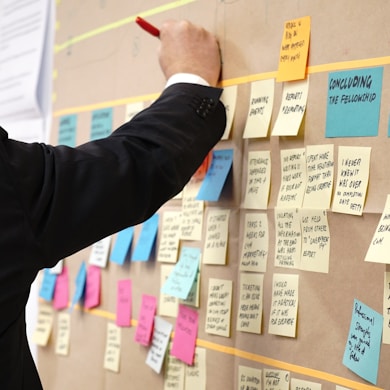Skip to content
Three additional core competencies: The competency aligns strategy and execution by applying Lean and systems thinking approaches to strategy and investment funding, Agile portfolio operations, and governance The competency describes a set of values and practices that encourage individuals—and the enterprise as a whole—to continually increase knowledge, competence, performance, and innovation The competency describes how Lean-thinking people and Agile teams optimize their business processes, evolve strategy with clear and decisive new commitments, and quickly adapt the organization as needed to capitalize on new opportunities The portfolio level roles, events, and artifacts The full spanning palette
– Every value stream has to fund the people and resources necessary to build that deliver value to the internal or external customer – Lean budgeting allows fast and empowered decision-making, with appropriate financial control and accountability through – The portfolio Kanban system makes the work visible and uses Work-in-Process (WIP) limits to help assure that demand is matched to the actual capacity of value streams and Agile Release Trains (ARTs) – The portfolio Vision is a description of the future state of a portfolio’s Value Streams and solutions and describes how they will cooperate to achieve the portfolio’s objectives and the broader aim of the Enterprise – The portfolio canvas provides critical inputs to the portfolio vision, Portfolio Backlog, and Lean Budgets.
(LPM) – This function represents the individuals with the highest level of decision-making and financial accountability for a SAFe portfolio – Take responsibility for coordinating portfolio Epics through the portfolio Kanban system – Enterprise architects work across value streams and ARTs to help provide the strategic technical direction that can optimize portfolio outcomes
Portfolio Sync – The Portfolio Sync provides visibility into how well the portfolio is progressing toward meeting its strategic objectives and may include reviewing value stream and program execution and governance of other portfolio investments – This event enables LPM to collaborate with and other relevant stakeholders to right-size the investments in value streams and helps manage the approval process of epics in the portfolio Kanban Strategic Portfolio Review – This event enables LPM to create alignment and investment guidance to inform rapid, high quality, decentralized decisions; adapt to meet changing needs; and provide governance necessary to effectively respond to new and changing opportunities
– Provide specific, itemized business objectives that connect the portfolio to the evolving enterprise business strategy – The portfolio Vision is a description of the future state of a portfolio’s and and describes how they will cooperate to achieve the portfolio’s objectives and the broader aim of the Enterprise Solution Investments by Horizon – Assists the portfolio in ensuring managing near and long-term solution investments – describe the portfolio’s policies and practices for budgeting, spending, and governance – Captures and reflect the new business capabilities that can only be provided through cooperation among value streams. Each Epic is supported by the Epic Hypothesis Statement, and Lean Business Case for those epics that make it to the analysis state – Reflect the architectural, technology, and business process initiatives that are necessary to enable new Features and Capabilities – The highest-level backlog in SAFe, it holds approved business and enabler epics that are required to create a portfolio solution set. This provides the competitive differentiation and/or operational efficiencies necessary to address the strategic themes and facilitate business success – The portfolio canvas defines the value streams that are included in a SAFe portfolio, the value propositions and the solutions they deliver, the customers they serve, the budgets allocated to each value stream, and other key activities and events required to achieve the portfolio vision

 Portfolio SAFe 5
Portfolio SAFe 5
Content Page. Portfolio SAFe aligns strategy with execution and organizes solution development around the flow of value through one or more value streams.


To succeed in the long term, focus on the middle term. —Geoffrey Moore
Portfolio SAFe
The portfolio configuration, which includes Essential SAFe, is the smallest configuration that can be used to achieve and consists of the following (Figure 1):


Figure 1. SAFe Portfolio
Details
A SAFe portfolio aligns strategy to execution via a collection of development value streams. Operating under a common governance model, each value stream provides one or more solutions the enterprise needs to accomplish its business mission. The Portfolio aligns enterprise strategy to portfolio execution by organizing the Lean-Agile Enterprise around the flow of value through one or more value streams. Delivering the basic budgeting and necessary governance mechanisms, including Lean Budget Guardrails, it helps assures that the Value Streams are focused on building the right things with the appropriate level of investments in solutions in order for the portfolio to meet its strategic objectives.
The remainder of this article describes the highlights, roles, events, and artifacts present in the portfolio level (Figure 2). These items are in addition to the ones described in Essential SAFe.


Figure 2. Portfolio level
Portfolio Level Highlights
Highlights of the Portfolio level include:
Roles
The portfolio function and associated roles provide the highest level of accountability and governance, including the coordination of multiple value streams.
Events
The following events support the alignment of strategy with execution:
Artifacts
The following artifacts help describe the strategic intent of the portfolio solution set:
Learn More
[1] Leffingwell, Dean. Agile Software Requirements: Lean Requirements Practices for Teams, Programs, and Portfolio. Addison-Wesley, 2011.
Navigation Bar
© Scaled Agile, Inc.
Include this copyright notice with the copied content.
Read the FAQs on how to use SAFe content and trademarks here:
Explore Training at:
Want to print your doc?
This is not the way.
This is not the way.

Try clicking the ··· in the right corner or using a keyboard shortcut (
CtrlP
) instead.

